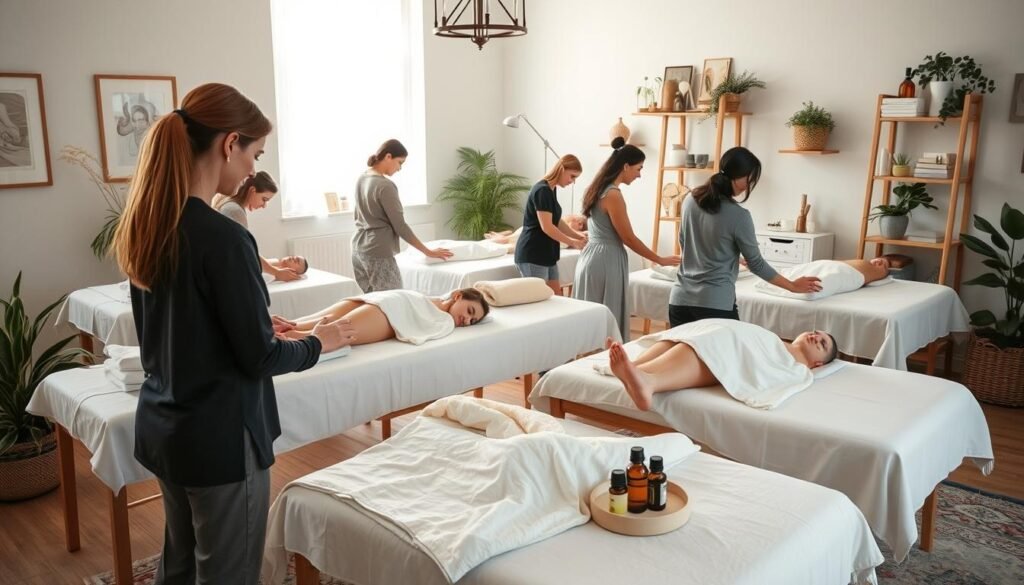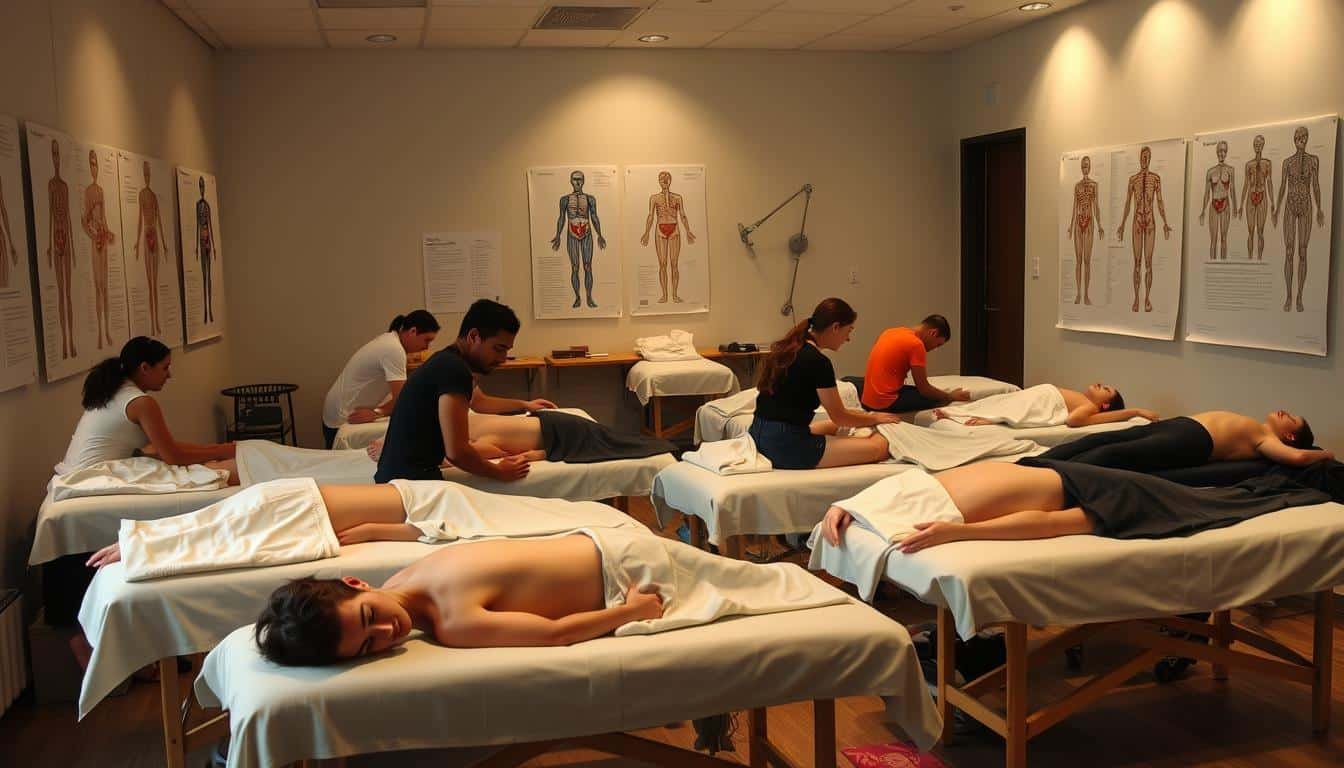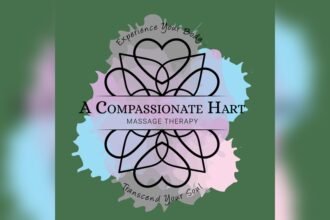Ever wondered what it takes to become a skilled massage therapist? The path to this rewarding career might surprise you. Massage therapy education requirements vary, but they’re designed to equip you with the knowledge and skills needed to help others heal and relax.
I’ve explored the world of massage therapist training programs, and I’m here to share insights on what it takes to enter this field. From hands-on techniques to understanding the human body, massage therapy certification is a journey of learning and growth.
Let’s dive into the details of massage therapy education and uncover what you need to know to start your career in this healing profession. Whether you’re considering a career change or just curious about the process, I’ve got you covered.
Key Takeaways
- Massage therapy programs typically require 500-1,000 hours of training
- Training duration ranges from 6 to 12 months for most programs
- Programs offer certificates, diplomas, or associate degrees
- Curriculum includes anatomy, physiology, and hands-on practice
- Most states require licensing through exams like the MBLEx
- Continuing education is often needed to maintain certification
Understanding Massage Therapy Education Requirements
Exploring massage therapy education can be tricky. Knowing about different programs and what’s needed is key. Let’s look at the main parts of massage therapy school and licensing rules.
Certificate vs. Diploma Programs
There are two main types of massage therapy courses: certificates and diplomas. Certificates are shorter, teaching the basics. Diplomas take longer, offering deeper learning. Both can help you get a massage therapy license, depending on where you live.
| Program Type | Duration | Focus |
|---|---|---|
| Certificate | 6-8 months | Basic techniques, anatomy |
| Diploma | 12-18 months | Advanced techniques, business skills |
Length of Training Programs
How long massage therapy courses last varies a lot. They usually last from 6 to 18 months. Full-time students finish quicker, while part-time students have more flexibility.
State-Specific Regulations
Every state has its own rules for getting a massage therapy license. Some need 500 hours of training, while others ask for up to 1,000. It’s important to check your state’s rules when picking a program. The curriculum should match state standards to pass licensing exams.
“Understanding state regulations is key to planning your massage therapy education journey.”
By understanding these basics, aspiring massage therapists can make better choices about their education and future.
Core Curriculum in Massage Therapy Programs

Massage therapy programs have a detailed curriculum. It’s designed to give students the knowledge and skills they need. The main areas covered are anatomy and physiology, kinesiology, and various massage techniques.
Anatomy and Physiology
This part of the program teaches about the human body’s structure and functions. We learned over 2,500 anatomical terms, covering all major body systems. This knowledge is key to understanding how massage affects the body.
Kinesiology
Kinesiology is about body movement. We studied how muscles, bones, and joints work together. This helped us understand the mechanics behind different massage techniques and their effects on the body.
Massage Techniques and Modalities
This part is all about practicing different massage styles. We learned Swedish massage, deep tissue work, and more. The focus was on proper technique, client communication, and tailoring treatments to each person’s needs.
| Core Subject | Topics Covered | Typical Hours |
|---|---|---|
| Anatomy & Physiology | Body systems, tissues, cells | 150-200 |
| Kinesiology | Muscle actions, joint movements | 100-150 |
| Massage Techniques | Swedish, deep tissue, sports massage | 200-250 |
Many programs also include courses on ethics, business skills, and pathology. These subjects prepare students for the professional side of a massage therapy career. They add to the comprehensive education needed in this field.
Prerequisites for Massage Therapy School
Before starting your massage therapy career, it’s key to know what you need for school. Most programs ask for a high school diploma or GED. This helps students have the basics to do well in the program.
Some schools might ask for more to begin your massage therapy journey. These could be:
- Basic anatomy knowledge
- CPR certification
- First aid training
- Physical fitness assessment
- Background check
I suggest checking with schools directly to see what they need. It’s important to make sure the program fits with state licensing rules. This helps you smoothly start your massage therapy career.
| Prerequisite | Typical Requirement | Purpose |
|---|---|---|
| Education | High school diploma or GED | Ensures basic academic skills |
| Age | 18 years or older | Legal requirement for practice |
| Health | Physical exam | Confirms ability to perform massage |
| Character | Background check | Ensures ethical practice |
By fulfilling these requirements, you’ll be ready to start your massage therapy certification. You’ll be on your way to a fulfilling career in this field.
How Much Schooling to Be a Massage Therapist

Ever wondered about the education needed to be a massage therapist? I’ve uncovered the details on the schooling required. Becoming a massage therapist involves intense training and practical experience.
Typical Program Duration
Massage therapy programs last from 6 to 12 months. They require 500 to 1,000 hours of study. The exact time depends on the school and local laws.
Full-Time vs. Part-Time Options
Schools offer both full-time and part-time programs. Full-time students finish in 6-8 months. Part-time programs take longer but are great for those with work or family commitments.
| Program Type | Average Duration | Weekly Hours |
|---|---|---|
| Full-Time | 6-8 months | 30-40 hours |
| Part-Time | 12-18 months | 15-20 hours |
Advanced Training Opportunities
After basic training, you can get advanced certifications. Specializations like sports or medical massage boost your skills and career. These extra courses may add to your education time but open new paths in massage therapy.
Knowing the schooling needed to be a massage therapist helps plan your career. Whether you pick a full-time or part-time program, you’ll learn the skills to start your rewarding career.
Hands-On Training and Clinical Experience

Hands-on training is key in massage therapist programs. It’s essential for learning the skills needed to succeed. Massage therapy courses include lots of practice, helping students apply what they’ve learned in real situations.
Most courses have supervised clinical practice. This lets students work with real clients under experienced instructors. It’s here that I honed my skills, got better at feeling clients’ muscles, and learned to talk to them professionally.
The number of clinical hours needed varies by program and state. Here’s a look at typical hours needed in different areas:
| Region | Minimum Clinical Hours | Maximum Clinical Hours |
|---|---|---|
| Northeast | 100 | 200 |
| Midwest | 150 | 250 |
| South | 125 | 225 |
| West | 200 | 300 |
This hands-on training was priceless for me. It made me confident, professional, and able to adjust my methods for each client.
Online vs. In-Person Massage Therapy Education
Exploring massage therapy education, I see both online and in-person programs have their good points. The curriculum can differ based on the type of program. Let’s look at the differences and what to consider for each.
Limitations of Online Learning
Online massage therapy courses offer flexibility, but they have their limits. The hands-on nature of massage makes it hard to learn just online. Skills like proper technique and client interaction need in-person teaching.
Online programs do well with theory like anatomy and physiology. But, they struggle with teaching the practical skills needed for a massage career. Skills like technique, pressure, and client interaction are key.
Hybrid Program Options
Hybrid programs offer a mix of online and in-person learning. They let students learn theory online and practice skills on campus. This way, students get the best of both worlds.
In a hybrid program, I might learn about business ethics and pathology online. Then, I’d go to in-person classes to practice massage techniques. This is great for those with busy lives or far from campus.
When deciding between online and in-person courses, think about your learning style, schedule, and career goals. While online programs are rare, hybrid options are a good compromise for future massage therapists.
Choosing the Right Massage Therapy School
Finding the right massage therapy school is a big step in your career. It’s important to think about several key factors. These will help shape your education and future success.
Accreditation and Licensing Considerations
Always check if the school is accredited by groups like the Commission on Massage Therapy Accreditation (COMTA). This shows the program is up to standard. It also means you’ll be ready for massage therapy certification.
Curriculum Evaluation
Looking at the curriculum is crucial. I search for programs that teach a variety of techniques. They should also meet state licensing needs. This gives you a strong start in your massage career.
Faculty Expertise and Experience
The teachers’ quality is key to your learning. I check their backgrounds and skills in different massage methods.
| Consideration | Why It’s Important |
|---|---|
| Accreditation | Ensures program quality and recognition |
| Curriculum | Prepares for certification and career success |
| Faculty Expertise | Provides valuable industry insights |
| Facilities | Offers hands-on training opportunities |
By looking at these factors, you can pick a school that fits your goals. This will help you start a fulfilling massage therapy career.
Massage Therapy Licensing and Certification
Getting a massage therapy license is key to starting your career. Most states need this to work legally. You’ll need to finish an accredited program and pass a national exam, like the Massage and Bodywork Licensing Examination (MBLEx).
State rules for a massage therapy license differ. Some might ask for background checks or more classes. Always check your state’s rules. With a license, you can work in spas, clinics, or even start your own business.
For career growth, consider voluntary board certification. The National Certification Board for Therapeutic Massage & Bodywork (NCBTMB) offers this. It can lead to better jobs and specialized roles.
| Requirement | Details |
|---|---|
| Education | Accredited massage therapy program |
| Exam | MBLEx (in most states) |
| State-specific | Background check, additional courses |
| Advanced certification | NCBTMB board certification (optional) |
Remember, keeping your massage therapy certification current is important. You’ll need to keep learning. This ensures your skills stay sharp and you’re up-to-date with new techniques and standards.
Specializations and Advanced Certifications in Massage Therapy
Exploring the massage therapy career path reveals exciting specializations. Advanced certifications significantly improve the job outlook. Let’s look at some popular specializations that can boost your career.
Sports Massage
Sports massage is all about helping athletes. It prevents injuries, boosts performance, and aids in recovery. It’s ideal for those who love sports and want to work with athletes at all levels.
Medical Massage
Medical massage treats specific health issues. It requires a deep understanding of health and medical procedures. This specialization can lead to jobs in hospitals, clinics, and rehabilitation centers.
Prenatal and Infant Massage
This specialization is for expectant mothers and newborns. It uses gentle techniques to ease pregnancy discomfort and support infant development. Many parents seek these services, making it a rewarding career choice.
The National Certification Board for Therapeutic Massage and Bodywork offers specialty certificates. These include oncology massage and pain management. These certifications improve job prospects and open doors to specialized settings.
“Advanced certifications in massage therapy not only expand your skill set but also open doors to diverse career opportunities.”
By pursuing these specializations, I can tailor my massage therapy career path. The job outlook for massage therapists remains positive, especially with advanced skills and certifications.
Career Opportunities After Massage Therapy School
The massage therapy career path is full of options. After finishing school, you can work in many places. Spas, fitness centers, chiropractic offices, and hospitals all need skilled therapists. Some even start their own practices.
The job outlook for massage therapists is bright. The U.S. Bureau of Labor Statistics says jobs will grow by 17.7% by 2033. This is much faster than most jobs. More healthcare providers are seeing the value of massage, which means more jobs for skilled people.
Think about specializing to boost your career. Options like sports massage, medical massage, and prenatal massage are in demand. These specializations can lead to better pay and unique work settings.
- Spa and resort therapist
- Corporate massage provider
- Cruise ship massage therapist
- Sports team massage specialist
- Hospice care massage therapist
Getting more certifications and keeping up with trends can make your career fulfilling. The field is growing and offers many opportunities. It’s a great choice for those who love healing and wellness.
Continuing Education for Massage Therapists
As a massage therapist, I know my education never ends. Continuing education is key to keep my license and stay updated. Most states need us to keep learning to stay sharp and informed.
Required Continuing Education Hours
The hours needed vary by state, but it’s usually 12 to 24 hours every two years. These courses are a treasure trove for improving my skills and learning new things. They cover everything from massage techniques to business skills, helping me grow.
Specialty Certifications
Many of us aim for specialty certifications to boost our skills. These programs focus on areas like sports massage, oncology massage, or prenatal care. Getting these certifications can lead to new career paths and higher pay. It’s a smart move to stand out in the massage therapy world.
Continuing education is more than just meeting requirements. It’s about being the best therapist I can be. By keeping up with new techniques and research, I give my clients the best care. It’s a lifelong commitment to learning that benefits everyone.
FAQ
What is the typical curriculum for massage therapy programs?
How long does it take to become a massage therapist?
Are there any prerequisites for enrolling in a massage therapy school?
Can I complete a massage therapy program online?
How do I choose the right massage therapy school?
What are the licensing and certification requirements for massage therapists?
What specializations can massage therapists pursue?
What are the career opportunities for massage therapists?
Are continuing education requirements necessary for massage therapists?
Source Links
- What Are The Requirements For Being A Massage Therapist ? – https://www.careervillage.org/questions/887695/what-are-the-requirements-for-being-a-massage-therapist
- Massage Therapy Schools (Education Guide) – Natural Healers – https://www.naturalhealers.com/massage-therapy/education-requirements/
- Education You’ll Need to Become a Massage Therapist – https://www.allalliedhealthschools.com/massage-therapist/education/













7 Comments
Honestly, isnt it more about skill and experience than the length of the training program for massage therapists?
Does anyone else think that the length of training programs should be proportional to the complexity of techniques taught?
Does massage therapy education really need to be so long? Surely hands-on experience is more valuable than endless schooling?
Experience is key, but without the right education, youre just rubbing people the wrong way.
Interesting read, but shouldnt practical experience weigh more than the length of training programs in massage therapy?
Interesting read, but arent the hours for training programs quite subjective? Depends on the individuals learning capacity, right?
Absolutely! One-size-fits-all approaches to learning are outdated. Individual capacity is key.